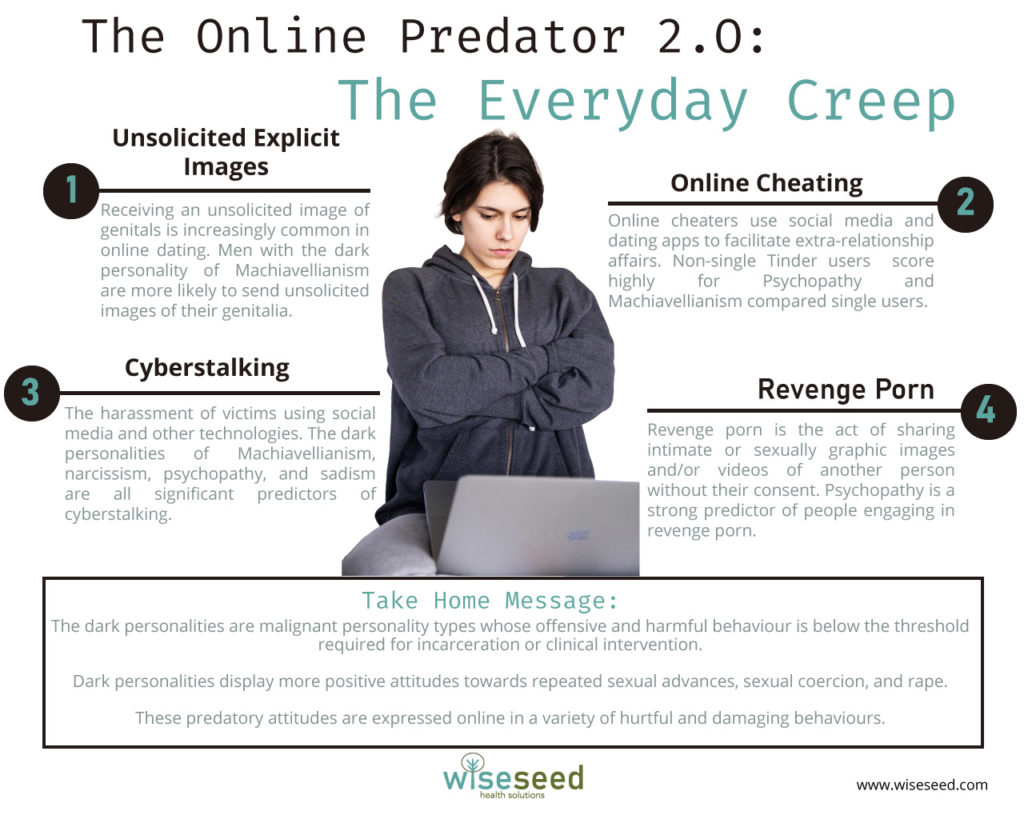Online Predators 2.O: The Everyday Creep

Introduction
This is the second instalment of our series on online predators. Our first article dealt with people who engage in low-level online hate, whom we call everyday haters. This article is focused on low-level online harassment of a sexual nature, perpetrated by people we refer to as everyday creeps.
The Dark Personalities: A Quick Recap
The dark personalities are sub-clinical or everyday manifestations of the personality disorders Machiavellianism, narcissism, psychopathy, and sadism, which are collectively known as the Dark Tetrad 1.
The everyday Machiavellian cynically manipulates and takes advantage of others to achieve their own selfish goals 1.
The everyday narcissist is characterised by a grandiose sense of self-importance, superiority, and entitlement 1.
The everyday psychopath is callous and lacks remorse, while expressing an aggressive interpersonal style that involves subtle forms of humiliation, retaliation, scorn, and the threat of violence 1.
Finally, the everyday sadist simply enjoys inflicting psychological and physical pain onto others 1.
| Feature | Narcissism | Machiavellianism | Psychopathy | Sadism |
| Callousness | High | High | High | High |
| Selfishness | High | High | High | High |
| Impulsivity | Moderate | Low | High | Low |
| Manipulation | Moderate | High | High | Low |
| Criminality | Low | White Collar | High | Low |
| Grandiosity | High | Low | Moderate | Low |
| Enjoyment of Cruelty | Low | Low | Low | High |
Note that all dark personalities are both selfish and callous (Table 1). This combination endows the dark personalities with a predatory approach to life. Unsurprisingly, people with dark personalities often deploy a predatory approach to sex and relationships. For example, dark personalities tend to display more positive attitudes towards repeated sexual advances 2, sexual coercion 3, and rape 4. Naturally, these predatory attitudes are expressed online in a variety of hurtful and damaging behaviours.
Unsolicited Explicit Images
Receiving an unsolicited image of genitals, known as the dreaded ‘dick pic’, is an increasingly common occurrence in online dating. Appallingly, this is often the first communication a woman receives from her potential suitor . From a woman’s point of view, an unsolicited ‘dick pic’ is unwanted, can be shaming, and is usually interpreted as a form of sexual harassment 5.
In contrast, men love receiving unsolicited images of their prospective Date’s junk. For example, in a study of the dating habits of homosexual men on the online dating apps Grindr and Scruff, the unsolicited ‘dick pic’ garnered mainly positive responses 6. Further, the vast majority of straight males who received an unsolicited genital picture while online dating were delighted, and expressed extreme enthusiasm about meeting the woman who sent the image!
Second, and this may come as a shock to some, many men significantly over-rate their sexual appeal relative to their objective reality. This self-inflation, combined with the fact that most men enjoy receiving unsolicited sexual images, goes some way to explaining the modern epidemic of ‘dick pics’ within the online dating scene 7.
There is, however, a more sinister side to the ‘dick pic’ phenomenon. Machiavellian men are more likely to send unsolicited images of their genitalia 7. Everyday Machiavellians’ are expert behavioural strategists, who effectively exploit others for their own selfish benefit. In this instance, the unsolicited ‘dick pic’ is a strategy deployed by a selfish and callous master manipulator, who uses the ‘dick pic’ as a method to quickly screen social media dating apps for potential victims.
We suggest that instead of getting offended, you should use the unsolicited ‘dick pic’ as a strong indicator about the personality of your prospective date. If you are the unlucky recipient of a ‘dick pic’, you can be confident that the sender is either an over-inflated male who has no clue about women, or he’s a malignant and possibly dangerous dark personality trying to manipulate you for his own selfish reasons. Neither option is good. Swipe left Ladies. Swipe left.
Technology facilitated infidelity (TFI)
Technology facilitated infidelity is the phenomenon of people engaged in long-term relationships using social media and other platforms to facilitate extra-relationship affairs. According to data in the U.S., between 18-25% of people having on Tinder are married or in a relationship 8.
One could argue that non-single Tinder use may be for reasons other than sexual infidelity, such as engaging in social activities with like-minded people 8. However, the data indicates that this rarely seems to be the case. Non-single Tinder users report a higher number of romantic relationships, one-night stands, and casual sexual relationships with other Tinder users compared to the single Tinder users 8.
Non-single Tinder users also score highly for Psychopathy and Machiavellianism compared single users 8. Further, non-single Tinder users who scored highly in psychopathy reported significantly more one-night stands 8.
Frankly, it’s not at all surprising that dark personalities cynically use social media dating apps to create a target-rich mating environment. This pattern of opportunistic behaviour is consistent with previous studies linking Psychopathy with low-investment, short-term mating strategies 8.
Cyberstalking
Cyberstalkers are people who use technology to stalk their victims. As for classical stalkers, cyberstalkers are often a former intimate partner of the victim. Cyberstalking increasingly involves the contact and pursuit of victims through social media using fake online profiles, although other forms of technology are also employed 9,10. The appeal of cyberstalking is that it allows the perpetrator to secretly manipulate and spy on their victims, at their leisure, free from the constraints of geographical proximity 9.
Cyberstalking is a crime. The everyday creep knows this and will maintain their online stalking activities below the threshold that could trigger criminal prosecution. Nevertheless, all forms of cyberstalking inflict a heavy toll on their victims. The victims of cyberstalking experience depression and anxiety 9,10, changes in sleeping and eating patterns, and in severe cases can experience symptoms that are comparable to Post-Traumatic Stress Disorder 9,10.
Surprisingly, women make up the majority of cyberstalkers 9,10. Though unexpected, this revelation is consistent with previous research showing that women are more likely than men to engage in other covert stalking behaviours, such as reading texts, checking browser histories and making anonymous phone calls 9 10.

However, it’s important to highlight that female stalking victims are disproportionally at risk from serious violence and homicide at the hands of their intimate male partners. Controlling relationships are a known risk factor for stalking, domestic violence and femicide 10. Thus, for females, being stalked or cyberstalked by a current or former intimate partner represents a genuine threat of violence and should be taken very seriously.
The dark personalities of Machiavellianism, narcissism, psychopathy, and sadism are all significant predictors of cyberstalking 9. This is consistent with research showing that narcissism, psychopathy, and sadism are also associated with traditional stalking behaviours 9. A recent and more nuanced analysis of cyberstalking personality types suggests that for women, the dark personalities of narcissism and sadism are most predictive for cyberstalking. In contrast, psychopathy is the most significant predictor of cyberstalking for men 10.
Non-consensual Image Sharing and Revenge Porn
Revenge porn is the act of sharing intimate, sexually graphic images and/or videos of another person on public online platforms without their consent 11. The images can either be produced consensually, or non-consensually through surveillance or hacking. The victim is often a former romantic partner of the perpetrator 11.
Because revenge porn is a crime, the everyday creep will limit themselves to sharing private and intimate images that are not graphic or nude. Nevertheless, such images can still damage reputations, affect employment prospects, attract unwanted attention, and cause ongoing stress, anxiety and depression.
Revenge porn and non-consensual image sharing affects people of all ages, sex and gender 11. However, at present revenge porn is primarily perpetrated against, and most severely effects, women 11. The permanence and dissemination speed afforded by the internet causes the victims of revenge porn long-term harm and suffering.
Most shocking and damaging to victims are the existence of websites devoted to publishing revenge porn and displaying the victim’s personal information linking them to their social media accounts 12. The people responsible for these sites profit from the victims’ distress while causing further immeasurable harm to the victim. Finally, the absence of victim anonymity encourages further harassment from other predators, both offline and online 11.
Not surprisingly, victims of revenge porn experience an array of negative effects, including the dissolution of relationships, problems with employment, and decreased self-esteem and feelings of shame 11. Some cases of revenge porn have resulted in the victim committing suicide 11.
To date, the single study examining the role of dark personalities in revenge porn has found psychopathy to be a strong predictor of people engaging in revenge porn 11.
| Behaviour | Predictive Personality Type |
| Unsolicited Explicit Images | Machiavellianism |
| Technology Assisted Infidelity | Psychopathy, Machiavellianism |
| Cyberstalking | Psychopathy, Machiavellianism, Narcissism, Sadism |
| Non-consensual Image Sharing | Psychopathy |
Conclusion
Over the last five years psychologists and social scientists have gained a deeper understanding of the sub-clinical personality disorders known as dark personalities. These individuals can be male, female or other. They can be adults or adolescents. The two consistent and unifying features of the dark personalities are callousness and selfishness, which underpins their predatory nature.
There is a growing body of evidence suggesting that a significant proportion of online hate and harassment is perpetrated by dark personalities (Table 2). If this hypothesis is true, it follows that learning to identify and avoid dark personalities can significantly reduce the risk that your children are exposed to online hate and harassment during the high-risk phases of childhood and adolescence. Our follow-up articles will provide tactics to help you identify and avoid dark personalities.
Please click on the link below for the free PDF of the article.

References and Further Reading
1 Paulhus, D. L. Toward a taxonomy of dark personalities. Current Directions in Psychological Science 23, 421-426 (2014).
2 Zeigler-Hill, V., Besser, A., Morag, J. & Campbell, W. K. The Dark Triad and sexual harassment proclivity. Personality and Individual Differences 89, 47-54 (2016).
3 Figueredo, A. J., Gladden, P. R., Sisco, M. M., Patch, E. A. & Jones, D. N. The unholy trinity: The Dark Triad, sexual coercion, and Brunswik-symmetry. Evolutionary Psychology 13, 147470491501300208 (2015).
4 Jonason, P. K., Girgis, M. & Milne-Home, J. The exploitive mating strategy of the Dark Triad traits: Tests of rape-enabling attitudes. Archives of sexual behavior 46, 697-706 (2017).
5 Vitis, L. & Gilmour, F. Dick pics on blast: A woman’s resistance to online sexual harassment using humour, art and Instagram. Crime, media, culture 13, 335-355 (2017).
6 Tziallas, E. Gamified eroticism: Gay male “social networking” applications and self-pornography. Sexuality & Culture 19, 759-775 (2015).
7 March, E. & Wagstaff, D. L. Sending nudes: Sex, self-rated mate value, and trait Machiavellianism predict sending unsolicited explicit images. Front Psychol 8, 2210 (2017).
8 Timmermans, E., De Caluwé, E. & Alexopoulos, C. Why are you cheating on tinder? Exploring users’ motives and (dark) personality traits. Computers in Human Behavior 89, 129-139 (2018).
9 Smoker, M. & March, E. Predicting perpetration of intimate partner cyberstalking: Gender and the Dark Tetrad. Computers in Human Behavior 72, 390-396 (2017).
10 March, E., Litten, V., Sullivan, D. H. & Ward, L. Somebody that I (used to) know: Gender and dimensions of dark personality traits as predictors of intimate partner cyberstalking. Personality and Individual Differences 163, 110084 (2020).
11 Pina, A., Holland, J. & James, M. The malevolent side of revenge porn proclivity: Dark personality traits and sexist ideology. International Journal of Technoethics (IJT) 8, 30-43 (2017).
12 Stroud, S. R. The dark side of the online self: A pragmatist critique of the growing plague of revenge porn. Journal of Mass Media Ethics 29, 168-183 (2014).
Disclaimer
The material displayed on this website is provided without any guarantees, conditions or warranties as to its accuracy.
Information written and expressed on this website is for education purposes and interest only. It is not intended to replace advice from your medical or healthcare professional.
You are encouraged to make your own health care choices based on your own research and in conjunction with your qualified practitioner.
The information provided on this website is not intended to provide a diagnosis, treatment or cure for any diseases. You should seek medical attention before undertaking any diet, exercise, other health program or other procedure described on this website.
To the fullest extent permitted by law we hereby expressly exclude all warranties and other terms which might otherwise be implied by statute, common law or the law of equity and must not be liable for any damages whatsoever, including but without limitation to any direct, indirect, special, consequential, punitive or incidental damages, or damages for loss of use, profits, data or other intangibles, damage to goodwill or reputation, injury or death, or the cost of procurement of substitute goods and services, arising out of or related to the use, inability to use, performance or failures of this website or any linked sites and any materials or information posted on those sites, irrespective of whether such damages were foreseeable or arise in contract, tort, equity, restitution, by statute, at common law or otherwise.

Ten Minutes is All You Need
Research has shown that ten minutes of moderate-to-vigorous exercise performed each day is enough to significantly reduce your risk of early death.
- « Previous
- 1
- …
- 31
- 32
- 33



